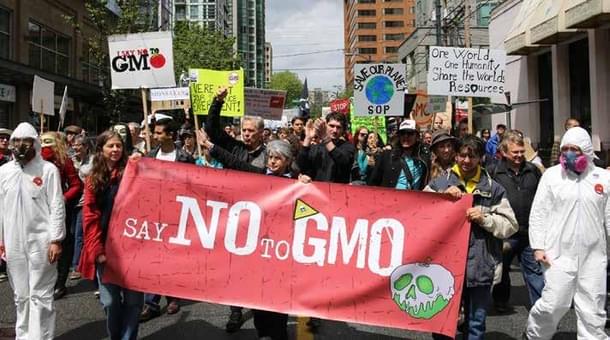Magazine
Why The World Loves To Hate GM Crops Despite Overwhelming Scientific Evidence In Its Favour
Vivian Fernandes
Mar 08, 2017, 05:21 PM | Updated 05:21 PM IST
Save & read from anywhere!
Bookmark stories for easy access on any device or the Swarajya app.


THE ONLY GENETICALLY modified (GM) plant crop in India to be approved for cultivation is bollworm-resistant Bt cotton. It was released in 2002. In 2010, then environment minister Jairam Ramesh imposed a moratorium on release of Bt brinjal though it had the same fruit borer-killing protein as Bt cotton and showed no harm to humans, animals and the environment in tests. Bangladesh allowed its cultivation in 2015 on the basis of Indian bio-safety data. In September 2015, a team of Delhi University scientists led by its former vice-chancellor Deepak Pental, a geneticist, applied for permission to commercially cultivate GM mustard hybrid, DMH-11.
The hybrid is struggling for approval despite environment minister Anil Madhav Dave telling Parliament that its tests have “adequately addressed” safety concerns.
B. Sesikaran, chairman of the Review Committee on Genetic Manipulation (RCGM), has told this correspondent that both GM mustard and Bt brinjal can be released as there is no evidence of them causing harm. K. Vinod Prabhu, joint director (research) at Indian Agricultural Research Institute (IARI) says “all safety issues have been perfectly taken care of” and the transgenic barnasebarstar system is a superior way of creating mustard hybrids than conventional cytoplasmic male sterility process.
In 2015, a little less than 180 million hectares (mha) were planted with GM crops across the world—a hundred-fold increase over 20 years. In 1996, when they were first grown commercially, 1.7 mha were planted. At 11.6 mha, India’s share of the global GM acreage is 6.5 per cent, all of it Bt cotton.
Yet the general public is iffy about GM crops, despite all the leading science academies including that of India holding that there is no evidence of existing GM crops posing new risks to human health or the environment.
Why were Green Revolution technologies and practices like high-yielding varieties and intensive use of chemical nutrients and pesticides acceptable but the gene revolution technology is not? In a paper, “The Political Economy of Bio-technology”, Ron Herring of Cornell University and Robert Paarlberg of Harvard Kennedy School look beyond the material interests of advocates and opponents of these technologies at political structures, social behaviour and public notions of acceptable risk.
The Green Revolution, they say, happened when mass hunger was feared. It was assumed that population growth would outstrip food supply. Governments poured money into research and western aid was generous. This was not entirely altruistic. The authors fail to mention that the rich capitalist countries were also driven by the fear of communism crawling on empty stomachs in poor countries.
By the time of the gene revolution, the fear of mass starvation had receded. Western aid for agriculture in poor countries became a trickle.
This coincided with the rise of trans-national NGOs like Greenpeace which believe nature should not be tampered with. They succeeded in painting GM plant crops as dangerous GMOs (genetically modified organisms), requiring special safeguards and approvals. They were aided by the loss of credibility which the British government suffered in 1996 over beef infected with mad cow disease—it had said it was safe for humans when it was not—when the first consignment of GM soyabean arrived in Europe from the United States. The NGOs held street demonstrations against the imports.
The campaign over time culminated in the European Union disallowing culti-vation of GM crops.
Western Europe also had to protect incumbent agri-chemicals companies whose business would have suffered if insect-resistant crops gained ground. Since GM maize and GM soyabean were extensively grown in the US, unlike in Europe, its farm lobbies pushed the technology.
The rest of the world accepted or rejected the technology based on where they were located in the spheres of influence and whether they were commodity exporters or not. The United States, Canada, Brazil, Argentina and Australia support the technology. Countries like Israel have shunned it, not for scientific reasons, but because they are large exporters of fresh fruits and vegetables to the EU and do not want to lose that market.
The GM crops that are being cultivated do not directly affect consumers. GM traits like insect resistance and herbicide tolerance reduce cost of cultivation. But production cost is a sliver of the final price that consumers pay and most of the gains from reduced costs are caught by farmers, seed companies and agricultural innovators.
It is not that there is outright rejection of transgenic technology. Recombinant DNA drugs, like human insulin, are widely used. Herring and Paarlberg believe this is because the medicines are individually prescribed. They are also produced in contained conditions. Exposure to GM plant crops on the other hand is involuntary and the crops are out in the open.
Society’s notions of acceptable risk may also have changed over time. NGOs opposing GM technology can speak with certitude; but science is not categorical. It cannot rule out risks from GM crops altogether for all times to come; there is that small chance of adverse consequences.
For these reasons, GM food crops are rare. The authors cite examples: genetically engineered (GE) wheat seeds were first field-tested in the US in 1994, but in 2004 Monsanto decided not to market them because activists persuaded consumers they might not be safe. Biotech rice also met the same fate. GE potatoes were grown on 25,000 acres in the US and widely consumed between 1999 and 2001 but cultivation was voluntarily suspended after a smear campaign. GE tomato was commercially cultivated in the US between 1998 and 2002. It was stopped under consumer pressure. The only GE foods currently grown in the US are Hawaiian papaya, summer squash and sweet corn on a small scale.
Outside the US, South Africa has allowed cultivation of GE white maize. Bangladesh has permitted Bt brinjal. The Philippines has allowed GM yellow maize.
Until consumers in rich countries change their minds about GMOs, farmers in most developing countries will be unable to use new varieties of GE food crops, or even existing varieties, the authors say. “Not for the first time in history, the tastes of the rich will drive welfare outcomes for the poor.”
Vivian Fernandes is editor of www.smartindianagricuture.in, a website devoted to promoting modern practices in agriculture including use of genetically-engineered seeds.





